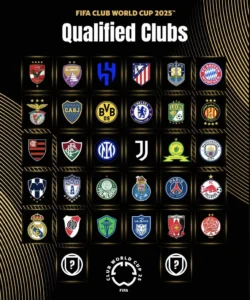For the first time in its history, the FIFA Club World Cup is not only expanding to a 32-team format but is doing so on a global stage in the United States. In June 2025, twelve cities across the U.S. will play host to elite clubs representing every corner of the footballing world. This landmark edition arrives just one year before the 2026 FIFA World Cup—co-hosted by the U.S., Canada, and Mexico—and offers a compelling preview of how the world’s game will reshape the American sports landscape.
More than just a warm-up for the global spectacle in 2026, the 2025 Club World Cup is a full-fledged competition in its own right. For fans stateside, it provides unprecedented access to iconic clubs—Real Madrid, Manchester City, Al Ahly, Palmeiras, and Inter Miami among them—on home turf. No passports needed. Just pitch-side passion.
The Expanded Format: Globalizing the Club Game
Historically, the FIFA Club World Cup was a modest seven-team tournament, often dismissed as a glorified exhibition where European champions typically strolled to victory. The 2025 edition disrupts that narrative with a format echoing the prestige of the men’s World Cup: 32 clubs, group stages, knockout rounds, and a final that could rival any Champions League night in terms of drama and spectacle.
For the first time, champions from all six confederations (UEFA, CONMEBOL, CONCACAF, CAF, AFC, and OFC) will face off alongside select runners-up, making the competition as deep as it is diverse. This inclusivity reflects FIFA’s ambition to elevate club football on a truly global scale. Clubs like Urawa Red Diamonds from Japan, Wydad Casablanca from Morocco, and Auckland City from New Zealand will now stand shoulder-to-shoulder with global powerhouses—a thrilling juxtaposition that could lead to surprising upsets and fresh storylines.
The Cities: America’s Footballing Map Gets Redrawn
The tournament’s matches will take place across 12 American cities, each offering unique flavor and significance. From traditional sporting meccas like Los Angeles, New York, and Chicago to newer soccer hotbeds like Austin, Atlanta, and Charlotte, the geographic spread illustrates just how rapidly football’s roots are spreading across the U.S.
Each venue—SoFi Stadium, Mercedes-Benz Stadium, MetLife, Soldier Field, and more—was selected not just for capacity and infrastructure, but for community relevance. In some cases, these stadiums are home to thriving MLS clubs whose fans are ready-made ambassadors for the world game. In others, they offer a blank slate—a chance to convert curious locals into lifelong supporters.
The Players: Messi, Vinícius Jr., Haaland, and New Icons
One of the tournament’s most anticipated storylines is Lionel Messi’s Inter Miami—not just for its sporting merit, but for what it symbolizes. A club barely five years old, based in a city historically indifferent to soccer, is now representing CONCACAF in a global tournament thanks to its Leagues Cup win. The Messi Effect is very real, and the Club World Cup may be its boldest chapter yet.
On the other end of the experience spectrum is Manchester City, a juggernaut under Pep Guardiola and UEFA Champions League holders. Their tactical supremacy and star-studded squad, featuring Erling Haaland and Kevin De Bruyne, promise spectacle and silverware. Then there’s Real Madrid, serial winners and perennial crowd-pullers, now reinvigorated by the electric Vinícius Jr. and rising Brazilian talent Endrick.
The chance to see such global icons play competitive football on American soil—not in post-season friendlies, but meaningful fixtures—marks a major shift in U.S. sporting culture.
Stakes and Spectacle: Why It Matters
Critics have long derided the Club World Cup as lacking prestige. That ends now. With a month-long format, meaningful matchups, and wide-scale broadcast coverage, the 2025 edition aims to forge new legitimacy. For players, it’s a chance to lift a FIFA-sanctioned trophy—especially for those from non-European clubs who rarely get to showcase their talents on a world stage.
Financially, the stakes are high. FIFA has poured hundreds of millions into the tournament’s infrastructure and marketing, betting that a successful Club World Cup will ignite greater passion for football across North America. Prize money has been significantly increased, and commercial sponsors—from streaming services to beverage brands—are treating the event as more than just a test run.
The U.S. Football Audience: From Niche to Nationwide
A decade ago, it would have been unthinkable for the U.S. to host such a competition and expect sellout crowds. But the last few years have seen a dramatic shift. MLS attendance records have broken yearly. Apple TV’s MLS Season Pass gained traction. The Women’s National Team has maintained cultural prominence. And most significantly, youth participation and immigrant-led fandoms have bolstered a grassroots passion that’s finally being recognized at the elite level.
The Club World Cup leverages this momentum. For newer fans, it’s an entry point—an opportunity to pick a team, learn the chants, and fall into the rhythms of international club fandom. For longtime supporters of global football, it’s a rare and welcome convergence: favorite teams from abroad, now playing meaningful matches in their backyard.
A Launchpad for 2026: Testing Grounds and Takeaways
Beyond the spectacle, the Club World Cup functions as a crucial stress test for 2026 FIFA World Cup logistics. From stadium tech to crowd control, transportation to hospitality, every element of the tournament will serve as a trial balloon. FIFA will monitor fan experience, ticketing demand, security protocols, and pitch conditions—using it all to fine-tune next year’s event.
The success of this Club World Cup could also influence World Cup ticketing strategies, accommodation plans, and even team base selections. For cities like Dallas or Kansas City, which may not have hosted a Champions League-level game before, this is a golden opportunity to prove readiness on the world stage.
Culture: Football, Food Trucks, and Flags
This isn’t just a sporting event—it’s a cultural happening. Tailgates will be diverse. Merchandise will fly off shelves. City centers will light up with global color. From taco trucks outside Inter Miami games to Nigerian drummers supporting Enyimba FC, expect cultural intersections at every matchday.
In a nation where major sports often exist in silos—NFL Sundays, NBA nights, MLB afternoons—the Club World Cup brings a cosmopolitan energy. One night, you’re in Seattle watching Flamengo face Monterrey. The next, you’re in Philly as Al Ahly battles PSG. This nomadic football feast is as much about shared experience as it is about goals.
A New Chapter Begins
The 2025 FIFA Club World Cup is more than a tournament—it’s a tipping point. A moment when the world’s favorite game fully arrives in the United States, not as an outsider, but as a main event. For American fans, it’s a gift. For clubs, a proving ground. For FIFA, a high-stakes trial. But for football itself, it’s just the beginning of a new chapter—where borders blur, clubs connect, and the beautiful game finds yet another home.
No comments yet.








